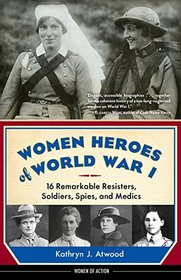Leo T. reviewed Women Heroes of World War I: 16 Remarkable Resisters, Soldiers, Spies, and Medics (Women of Action) on + 1775 more book reviews
A dandy book, discarded by a branch library after less than three years, and I am the first to read it. The brief biographies are well written and include a photo of the subject. Each section, such as 'Soldiers' is introduced nicely. The author often cites for further reading the postwar books, often long out of print, of these women of action.
There is a map as a frontispiece and enough endnotes (the target audience is YA). Glossary, index, and bibliography provided. Each essay has a sidebar or two, used as explanation, such as 'Queen Marie of Romania' for those who don't recall her visit to the US (when Grace Coolidge had to deal with her). I feel the author underestimates the knowledge of YA readers when she defines in parentheses terms such as 'dispatches'.
The first biographical essay is naturally Edith Cavell but different fronts of the Great War are covered, such as Ecaterina Teodoroiu of Romania and two X-ray technicians who, not wanted by the UK or France, were welcomed in the front lines of the Italian army operating on the Austrian front.
There is a five page introduction to the censorship that prevailed among the combatant nations, followed by essays memorializing two intrepid journalists: Mary Roberts Rinehart, an author who also published well received articles in The Saturday Evening Post, and Madeleine Zabriskie Doty, who was a correspondent for a succession of newspapers and reported from Germany although Kaiser Bill's minions felt she was a spy.
Several women serving as nurses and surgeons are remembered and the butchers' bill of dead combatants put at ten million.
The largest of the four parts of the book deals with 'Resistors and Spies.' The women are of very varied backgrounds but uniformly brave. I myself did not know that their were so many Allied soldiers wandering around in occupied Belgium (and parts of France) for so many months after the Boche victory.
I would criticize the handling of Armenia as I know Armenians, like so many other peoples at that time, attempted a revolution to establish their own republic. The Ottoman Empire was memorably known as the 'Sick Man of Europe'....
There is a map as a frontispiece and enough endnotes (the target audience is YA). Glossary, index, and bibliography provided. Each essay has a sidebar or two, used as explanation, such as 'Queen Marie of Romania' for those who don't recall her visit to the US (when Grace Coolidge had to deal with her). I feel the author underestimates the knowledge of YA readers when she defines in parentheses terms such as 'dispatches'.
The first biographical essay is naturally Edith Cavell but different fronts of the Great War are covered, such as Ecaterina Teodoroiu of Romania and two X-ray technicians who, not wanted by the UK or France, were welcomed in the front lines of the Italian army operating on the Austrian front.
There is a five page introduction to the censorship that prevailed among the combatant nations, followed by essays memorializing two intrepid journalists: Mary Roberts Rinehart, an author who also published well received articles in The Saturday Evening Post, and Madeleine Zabriskie Doty, who was a correspondent for a succession of newspapers and reported from Germany although Kaiser Bill's minions felt she was a spy.
Several women serving as nurses and surgeons are remembered and the butchers' bill of dead combatants put at ten million.
The largest of the four parts of the book deals with 'Resistors and Spies.' The women are of very varied backgrounds but uniformly brave. I myself did not know that their were so many Allied soldiers wandering around in occupied Belgium (and parts of France) for so many months after the Boche victory.
I would criticize the handling of Armenia as I know Armenians, like so many other peoples at that time, attempted a revolution to establish their own republic. The Ottoman Empire was memorably known as the 'Sick Man of Europe'....




